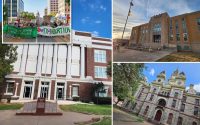NASA locks 4 volunteers into 3D-printed virtual ‘Mars’ for over a year
Four volunteers will spend the next 378 days in a simulation of Mars, facing harsh, realistic challenges in tight quarters under NASA’s watchful eye in preparation for a real-life mission to the red planet.
Research scientist Kelly Haston, structural engineer Ross Brockwell, emergency medicine physician Nathan Jones and US Navy microbiologist Anca Selariu were locked into the virtual planet at the Johnson Space Center in Houston, Texas, on Sunday as part of the first of a three-year-long simulation study by the space agency.
“The knowledge we gain here will help enable us to send humans to Mars and bring them home safely,” Grace Douglas, the mission’s principal investigator at NASA, said during a briefing.
Nasa 3D-printed the 1,700-square-foot facility, dubbed Crew Health and Performance Exploration Analog — or CHAPEA.
It will be the longest analog mission in the agency’s history.

The habitat — named Mars Dune Alpha — will feature a kitchen, private crew quarters, and two bathrooms, with medical, work, and recreation areas.
The crew will be expected to carry out “mission activities,” like collecting geological samples, exercising, and practicing personal hygiene and health care, with minimal contact with their family and loved ones, according to NASA.
To capture the true essence of life on our neighboring planet, the crew must work through “environmental stressors,” including limits on resources, periods of isolation, and equipment failures.


The only limitation the habitat can not simulate is Mars’ gravity, which is about 38% of Earth’s surface gravity.
This will be simulated by virtual reality from within the facility so researchers at NASA can study the crew participating in spacewalks, repairs to the habitat, and removing dust from their space suits and solar panels.
Haston, who will act as the commander of the mission, expressed her admiration for being part of the groundbreaking study, saying it “exemplifies some of the best qualities of humankind.”


Though none of the crew members are trained astronauts, Haston said her crew is an “amazing group of dedicated individuals who feel very passionate about space exploration and science.”
“The crew has worked so hard this month to get ready for this mission,” Haston shared in the press briefing before her crew and self were locked into the habitat.
“It has been very special to be a part of such a tremendous group of scientists and specialists from a diverse set of backgrounds working together to bring CHAPEA 1, the first of three missions, to reality.”
The data collected over the year will help scientists measure what a real crew heading to Mars may experience and will also serve as important information for vehicle planners at NASA.
The crew members waved to cheering onlookers as they entered the habitat.
“CHAPEA mission one is a go,” Douglas said after the habitat was officially sealed until July 7, 2024.


